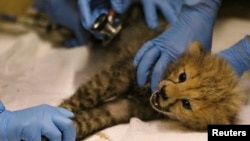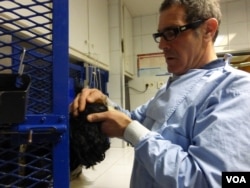PARIS —
Poaching, deforestation, human settlement and scarce prey are among the threats facing some of the planet's most iconic wild animals, from elephants and rhinos to lions and cheetahs. There are no easy solutions to save threatened species, but a group of veterinarians may be helping to boost their chances of survival.
The two-day-old kitten Dr. Jean-Yves Routier is examining has a big bandage wrapped around its middle. It was injured at birth, but it will survive.
The fate is less certain for some of the bigger cats the French veterinarian treats. When he is not at his clinic in the Paris suburb of Noisy le Grand, Routier is in Africa. He uses groundbreaking reproductive techniques to boost the numbers of cheetahs, lions and other game animals - and to diversify their gene pool.
The challenge, Routier said, is how to manage what he calls micro-populations - small populations of wild animals that are threatened, some to the verge of extinction. Zoos use artificial insemination and other techniques to induce pregnancy in captive animals. But that, he says, it does not save threatened species in the wild.
In 2002, Routier founded a nongovernmental organization called CRESAM. That stands for Conservation and Reproduction of Endangered Wild Species. He and his international team of highly specialized vets work with about 20 different species of carnivores in France and overseas. Many are big cats like cheetahs, living in private game parks. CRESAM is one of the rare organizations using artificial reproduction techniques outside of zoos.
A video on CRESAM's website shows Routier shooting a cheetah with a tranquillizer gun. Once down, the vets take blood samples of the animal. They have to work quickly. Within a few minutes, it will be back on its feet.
Cheetahs once roamed large chunks of Africa and Asia. But their numbers have plummeted from about 100,000 a century ago, to only about 7,000 to 15,000 today. The International Union for the Conservation of Nature lists cheetahs in general as a vulnerable species. Some subspecies are considered critically endangered. Luke Hunter, president of the global wildcat conservation organization Panthera, said big cats face a basic threat: competing with humans for space.
"The issue becomes the whole suite of threats that humans bring into landscapes in which large cats exist, which includes direct hunting of large cats for their furs or their bones or other things that are considered valuable for certain cultures. [Also] hunting and persecution of cats because they're considered dangerous, and just wiping out habitats and prey that big cats need," Hunter stated.
In the private reserves where Routier works, some cats face another problem.
Routier said the territory where these cats roam has shrunk and fragmented. So have the cheetah populations. This brings dangers of inbreeding, with diseases and bad genes spreading to the next generation. Routier is trying to create genetic maps. That allows his team to select sperm from males who are considered the best and healthiest reproducers to inject into females, who may live in a completely different place. That helps diversify their gene pool.
But artificial insemination is only one method CRESAM uses.
Routier said that in some game reserves, the problem of reproduction can be solved by simply injecting hormones into females who are in heat, and the reproductive cycle starts again. He said the vets have also created a sperm bank for felines - with an eye toward preserving future populations - and fine-tuned an ultra-rapid method of artificial insemination.
Routier grew up in France, but his father used to hunt in Africa with business colleagues.
Routier said business deals took place during those hunts. But his father hated hunting. He tried to avoid killing animals.
Routier's own contact with big game came after his brother died 14 years ago.
Routier said he began thinking what he wanted to do with his life besides being a vet. The answer: To help endangered species. But he did not just want to talk about it in scientific conferences. He wanted to be effective. A year later, he founded CRESAM.
Reproductive physiologist Pierre Comizzoli, who works at the Smithsonian's Center for Species Survival in Washington DC, is familiar with CRESAM and its assisted reproductive techniques.
"Using those kinds of techniques for wild populations may be helpful if you have fragmented, small populations of endangered species, and especially when individuals do not have the opportunities to mix and to reproduce with each other, because they are separated by geography and areas [space]," Comizzoli noted.
Panthera's Luke Hunter agreed CRESAM'S work can be useful in small conservation parks. But, he said, threatened species need a much broader solution.
"As far as artificial insemination or assisted reproductive helping in the wild, I think we are a massively long way from any wildcat species needing that in the wild. The absolute urgent priority is making sure that populations are reasonably well protected over reasonably large areas, and that they have the prey they need to survive. And then they will do that [reproduce] by themselves," said Hunter.
The Chinese Tiger - also known as the South China Tiger - is another story. China's iconic cat is CRESAM's next challenge. Scientists believe there are none left in the wild. The 28 or so that remain in China are all in captivity.
Routier said his team is in discussion with the Chinese government. They want to map the genes of the captive tigers to find those most capable of reproducing. The end goal: helping to reintroduce the tiger to the wild. Experts like Hunter say doing so would be enormously expensive. It demands a complex reintroduction plan, not to mention securing vast tracts of the tiger's natural habitat for conservation purposes. He questions whether that can be done.
But Routier is no stranger to challenge. Even with limited means, he believes, his small team is making a difference. That, he said, is how he judges success.
The two-day-old kitten Dr. Jean-Yves Routier is examining has a big bandage wrapped around its middle. It was injured at birth, but it will survive.
The fate is less certain for some of the bigger cats the French veterinarian treats. When he is not at his clinic in the Paris suburb of Noisy le Grand, Routier is in Africa. He uses groundbreaking reproductive techniques to boost the numbers of cheetahs, lions and other game animals - and to diversify their gene pool.
The challenge, Routier said, is how to manage what he calls micro-populations - small populations of wild animals that are threatened, some to the verge of extinction. Zoos use artificial insemination and other techniques to induce pregnancy in captive animals. But that, he says, it does not save threatened species in the wild.
In 2002, Routier founded a nongovernmental organization called CRESAM. That stands for Conservation and Reproduction of Endangered Wild Species. He and his international team of highly specialized vets work with about 20 different species of carnivores in France and overseas. Many are big cats like cheetahs, living in private game parks. CRESAM is one of the rare organizations using artificial reproduction techniques outside of zoos.
A video on CRESAM's website shows Routier shooting a cheetah with a tranquillizer gun. Once down, the vets take blood samples of the animal. They have to work quickly. Within a few minutes, it will be back on its feet.
Cheetahs once roamed large chunks of Africa and Asia. But their numbers have plummeted from about 100,000 a century ago, to only about 7,000 to 15,000 today. The International Union for the Conservation of Nature lists cheetahs in general as a vulnerable species. Some subspecies are considered critically endangered. Luke Hunter, president of the global wildcat conservation organization Panthera, said big cats face a basic threat: competing with humans for space.
"The issue becomes the whole suite of threats that humans bring into landscapes in which large cats exist, which includes direct hunting of large cats for their furs or their bones or other things that are considered valuable for certain cultures. [Also] hunting and persecution of cats because they're considered dangerous, and just wiping out habitats and prey that big cats need," Hunter stated.
In the private reserves where Routier works, some cats face another problem.
Routier said the territory where these cats roam has shrunk and fragmented. So have the cheetah populations. This brings dangers of inbreeding, with diseases and bad genes spreading to the next generation. Routier is trying to create genetic maps. That allows his team to select sperm from males who are considered the best and healthiest reproducers to inject into females, who may live in a completely different place. That helps diversify their gene pool.
But artificial insemination is only one method CRESAM uses.
Routier said that in some game reserves, the problem of reproduction can be solved by simply injecting hormones into females who are in heat, and the reproductive cycle starts again. He said the vets have also created a sperm bank for felines - with an eye toward preserving future populations - and fine-tuned an ultra-rapid method of artificial insemination.
Routier grew up in France, but his father used to hunt in Africa with business colleagues.
Routier said business deals took place during those hunts. But his father hated hunting. He tried to avoid killing animals.
Routier's own contact with big game came after his brother died 14 years ago.
Routier said he began thinking what he wanted to do with his life besides being a vet. The answer: To help endangered species. But he did not just want to talk about it in scientific conferences. He wanted to be effective. A year later, he founded CRESAM.
Reproductive physiologist Pierre Comizzoli, who works at the Smithsonian's Center for Species Survival in Washington DC, is familiar with CRESAM and its assisted reproductive techniques.
"Using those kinds of techniques for wild populations may be helpful if you have fragmented, small populations of endangered species, and especially when individuals do not have the opportunities to mix and to reproduce with each other, because they are separated by geography and areas [space]," Comizzoli noted.
Panthera's Luke Hunter agreed CRESAM'S work can be useful in small conservation parks. But, he said, threatened species need a much broader solution.
"As far as artificial insemination or assisted reproductive helping in the wild, I think we are a massively long way from any wildcat species needing that in the wild. The absolute urgent priority is making sure that populations are reasonably well protected over reasonably large areas, and that they have the prey they need to survive. And then they will do that [reproduce] by themselves," said Hunter.
The Chinese Tiger - also known as the South China Tiger - is another story. China's iconic cat is CRESAM's next challenge. Scientists believe there are none left in the wild. The 28 or so that remain in China are all in captivity.
Routier said his team is in discussion with the Chinese government. They want to map the genes of the captive tigers to find those most capable of reproducing. The end goal: helping to reintroduce the tiger to the wild. Experts like Hunter say doing so would be enormously expensive. It demands a complex reintroduction plan, not to mention securing vast tracts of the tiger's natural habitat for conservation purposes. He questions whether that can be done.
But Routier is no stranger to challenge. Even with limited means, he believes, his small team is making a difference. That, he said, is how he judges success.

